John 5’s distinguished playing and stage presence have made him one of today’s most identifiable guitarists – channel his brilliance with a lesson in his chicken pickin’ prowess, rapid-fire banjo rolls, and behind-the-nut bending
The man of many hats, face paints, and Teles guides GP through a gaggle of curated techniques culled from his catalog of solo albums

Growing up on a midwestern lake, under the wings of a loving family that would watch episodes of Hee Haw, a young John Lowery found the guitar at a tender age. With equal parts innate talent and boundless curiosity, combined with a traditional pioneer’s work ethic, the inspired adolescent set a goal to play the guitar and play it well, whether it be rock, metal, blues, or country. John was on a mission.
While he was still a teenager, John’s ethos, coupled with his laser-focused vision, led him to leave his beloved childhood home in Michigan for Los Angeles. It was in the City of Angels that he would eventually become the world-renowned guitar slinger known as John 5.
The path to that moniker, not to mention J5’s entire career, was born on a boast to budget-conscious record producers that he could “do their session in half the time and for half the price” required by other guitarists. Of the many attributes required to pull off such a feat in L.A.’s infamously competitive environment, versatility was paramount. Fortunately, John had it in spades.
Even so, competence and consistency are the golden tickets to entering and thriving in that world. After a few impressive and successful freelance recording sessions, word of John’s musical and technical competence spread quickly, and so did his connections with artists as far and wide as Lita Ford, k.d. lang, and Meat Loaf. Before long, John landed gigs with Rob Halford, David Lee Roth, Marilyn Manson, and Rob Zombie.
Today, as a full-time member of the venerable glam-metal outfit Mötley Crüe, John 5 has ascended through the ranks of top-gun electric guitar slingers thanks to his own almost freakish consistency, which is a direct result of his relentless commitment to playing guitar, in his words, “all the time.”

John 5’s distinguished playing and stage presence have made him one of today’s most identifiable guitarists, one who earned his place on the Mount Olympus of journeymen band-member gigs, while developing a high profile as a prolific solo artist.
In this lesson, the man of many hats, face paints, and Teles guides us through a gaggle of curated techniques culled from his catalog of solo albums. Armed with his own signature Fender Ghost Telecaster plugged straight into a chain of his requested “stock gear that is nothing special,” John 5 aims to help you develop your own consistency by giving you some fun stuff to play just as he does: all the time.
Typically, guitarists who wield a Tele exclusively embrace the country-oriented stylistic expectations that come with the axe. In this regard, John put in the time where it counts and packed his eclectic playing style and vocabulary with lots of fun and exciting country guitar techniques, such as chicken pickin’, behind-the-nut bends, moving bass lines, and rapid-fire banjo rolls, all while delivering the snap and feisty attack you’d expect.
Bolstering the fun factor in John’s playing is the fact that these idiomatic elements are thrown down at the drop of a hat by a leather-clad Kiss fanatic with gothic bug-eye sunglasses who happens to be in the world’s most celebrated glam-metal band.
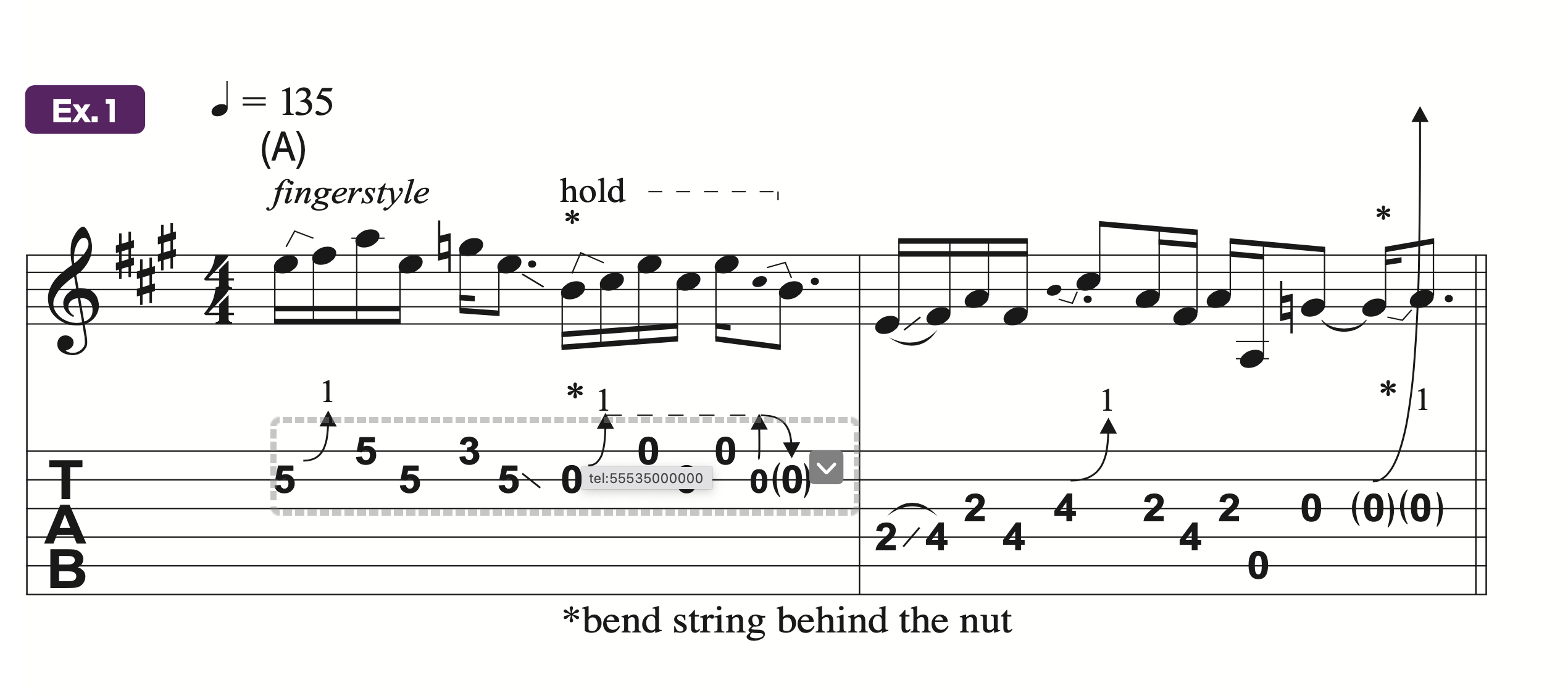
Ex. 1 puts John’s approach to chicken pickin’ and bending behind the nut front and center. He performs this phrase fingerstyle and navigates the nearly exclusive adjacent-string action with his pick-hand’s thumb (p) and first finger (i), assigned to the lower and higher strings in each pairing, while adding the requisite accent and note length articulations.
The cruxes of the lick, however, are the whole-step bends applied to the open B and G strings, for which he pushes down on them behind the nut at each juncture with his fret hand’s 2nd and 3rd fingers. Behind-the-nut bends are ideally suited to a Tele, given the extended space between the strings and tuners.
Taking a close look at John’s signature Tele reveals a string tree for the highest two strings, placed unconventionally far away from the nut. While this helps facilitate the technique, John removes the tree on his personal guitar altogether for even easier execution of this technique.
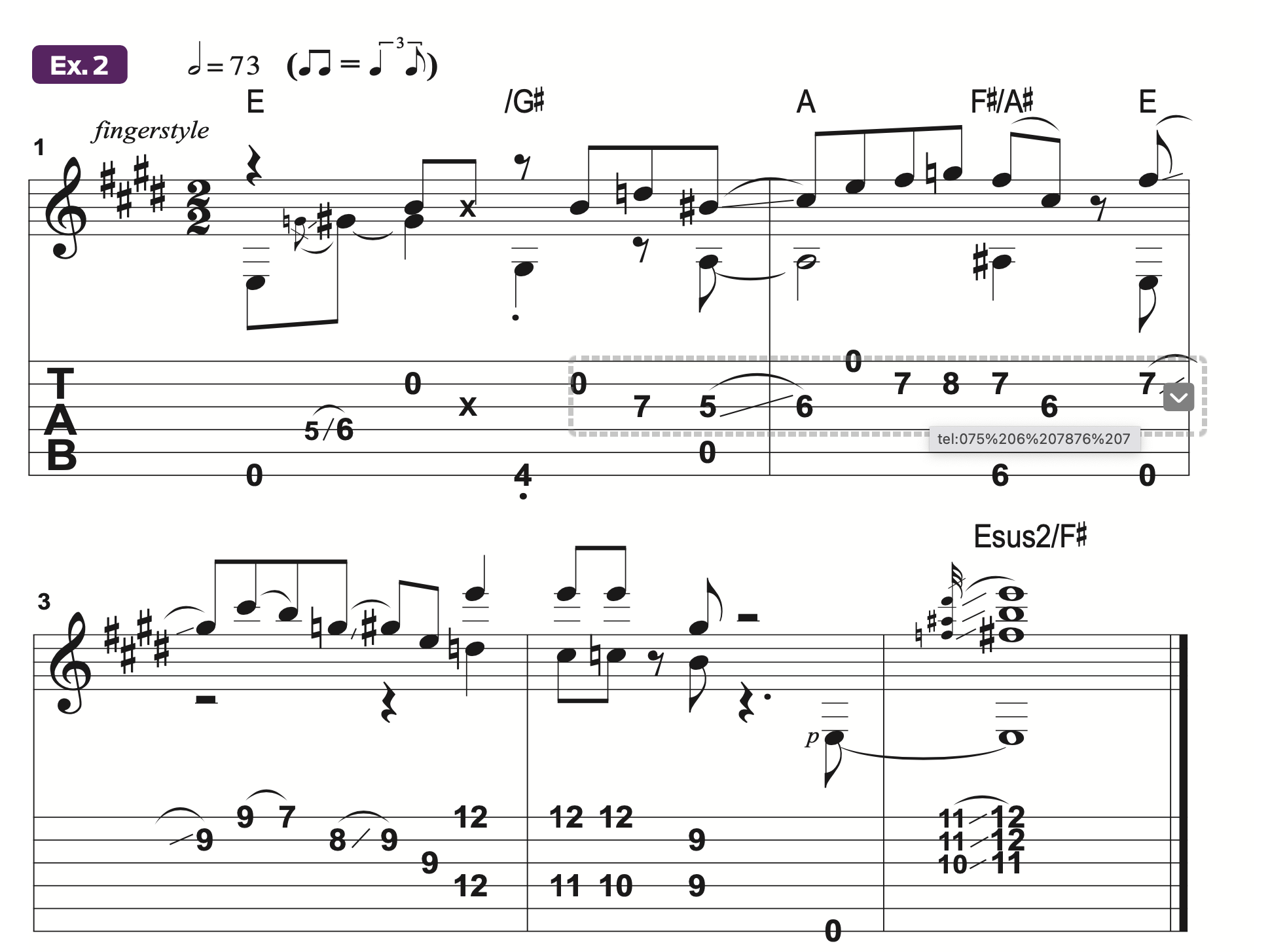
Continuing to make exclusive use of his pick-hand thumb and first finger, John shows off his moving bass-line skills with Ex. 2, his homage to country guitar legend Jerry Reed’s classic guitar instrumental Jiffy Jam, a tune John recorded for his 2014 release, Careful With That Axe.
He assigns his thumb to the down-stemmed bass notes while his first finger takes care of the rest, including a slick upward swipe of the Esus2/F# at the end of the phrase. As a result of John’s attentive fret-hand finger arching, the open strings clearly ring here while the fretted notes attacked with his pick-hand first finger are both slightly chopped in duration and accented alongside the more legato-sounding bass movement, resulting in a multifaceted performance.
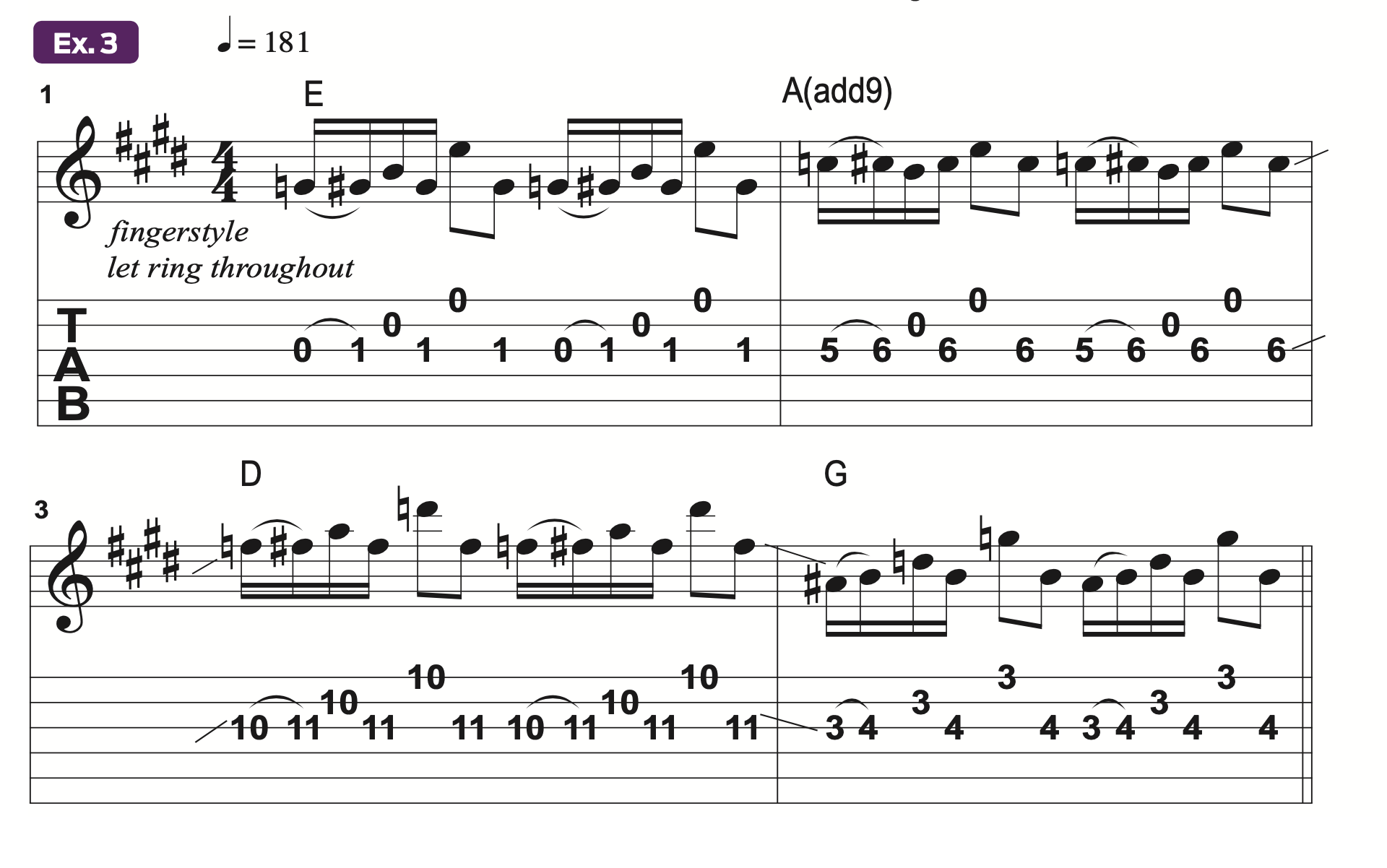
Adding his 2nd finger to the fingerpicking mix, John cracks the whip with Ex. 3, a burning four-bar run from his tune Howdy (from 2019’s Invasion). Assigning his thumb to the G string and his first and second fingers to the B and high E strings, respectively, the guitarist blazes through a consistent disjunct banjo-roll pattern that traverses major tonalities in E, A, D, and G, in 1st, 5th, 10th, and 3rd positions, respectively.
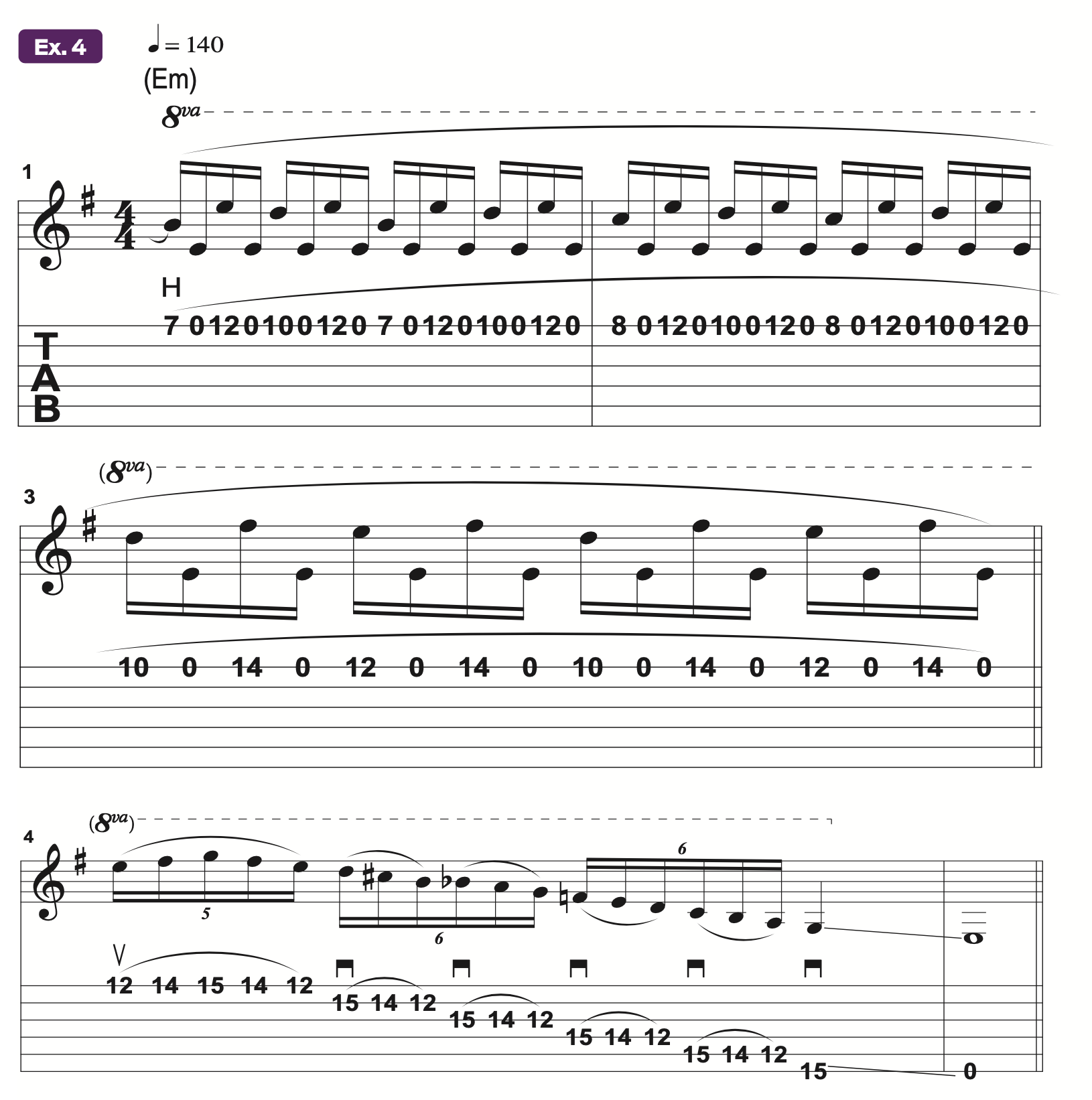
At this point in the lesson, John unleashes the power of his Ghost Tele’s DiMarzio D Activator pickups by switching to the hi-gain channel of the Marshall JVM half-stack that he’s plugged into, additionally slamming the front end of the amp with a Boss SD-1 Super overdrive pedal.
He proceeds to dive into his vat of shred techniques with a bevy of legato licks that retain the presence of open strings, starting with a lick from Creepshow, from 2021’s Sinner, as shown in Ex. 4.
Using only his high E string in bars 1 and 2, and no pick attacks, he hammers on and pulls off a sequence of notes from the E Aeolian mode (E, F#, G, A, B, C, D), separated by the open string, which serves as a pedal tone. He follows this in bar 3 with a descending legato run that moves across all six strings in a visually symmetrical and musically insurgent half-step/whole-step fretboard pattern that’s not beholden to any one scale, an approach popularized by Eddie Van Halen.
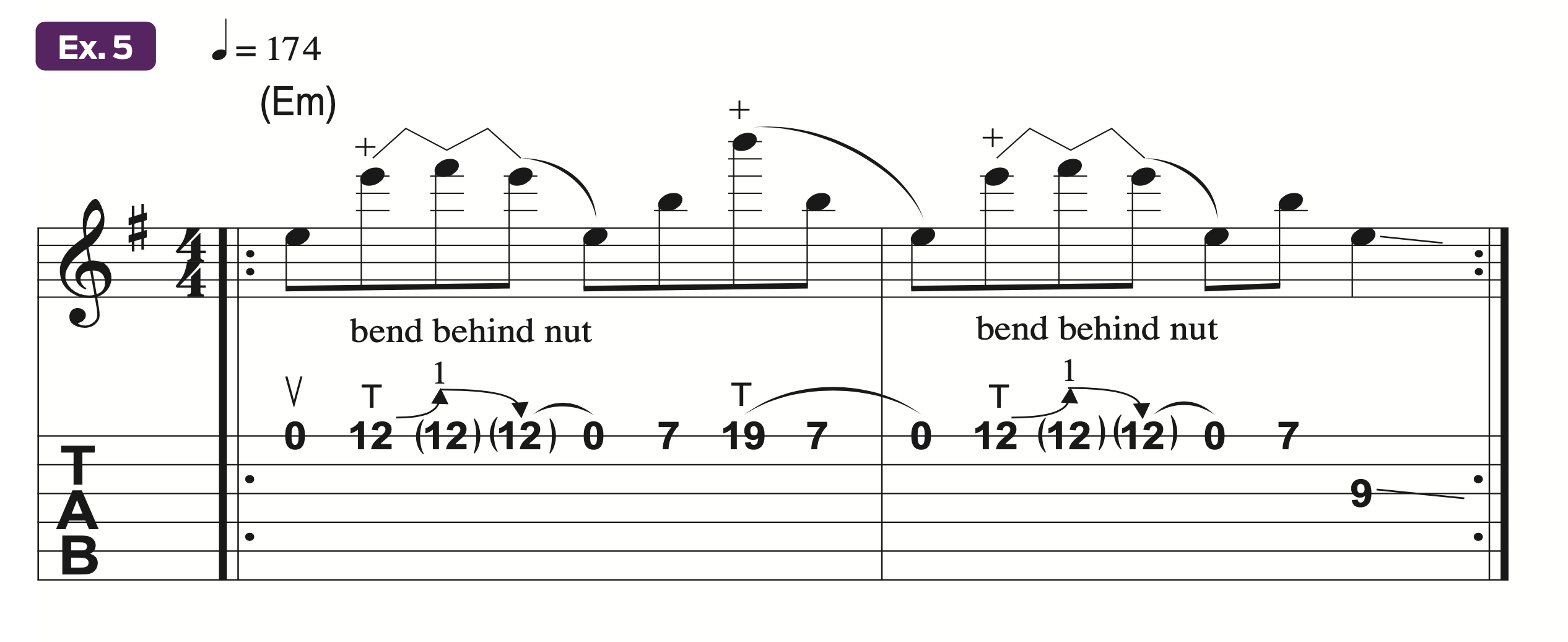
Offering us another selection from Sinner, John remains on his high E string for Ex. 5, a playfully angular lick from Euphoria. Notice how the line ricochets back and forth from the open string to notes tapped at the 12th and 19th frets and a 7th-fret B, fingered with the fret hand.
Not leaving his affinity for slick country playing behind when things get gainy, the crafty guitarist again reaches behind the nut and proceeds to bend each tapped 12th-fret E note up a whole step, to F#. No wonder he claims that this is “one of the most challenging things I do.” That may be hard to believe when you see what’s next.
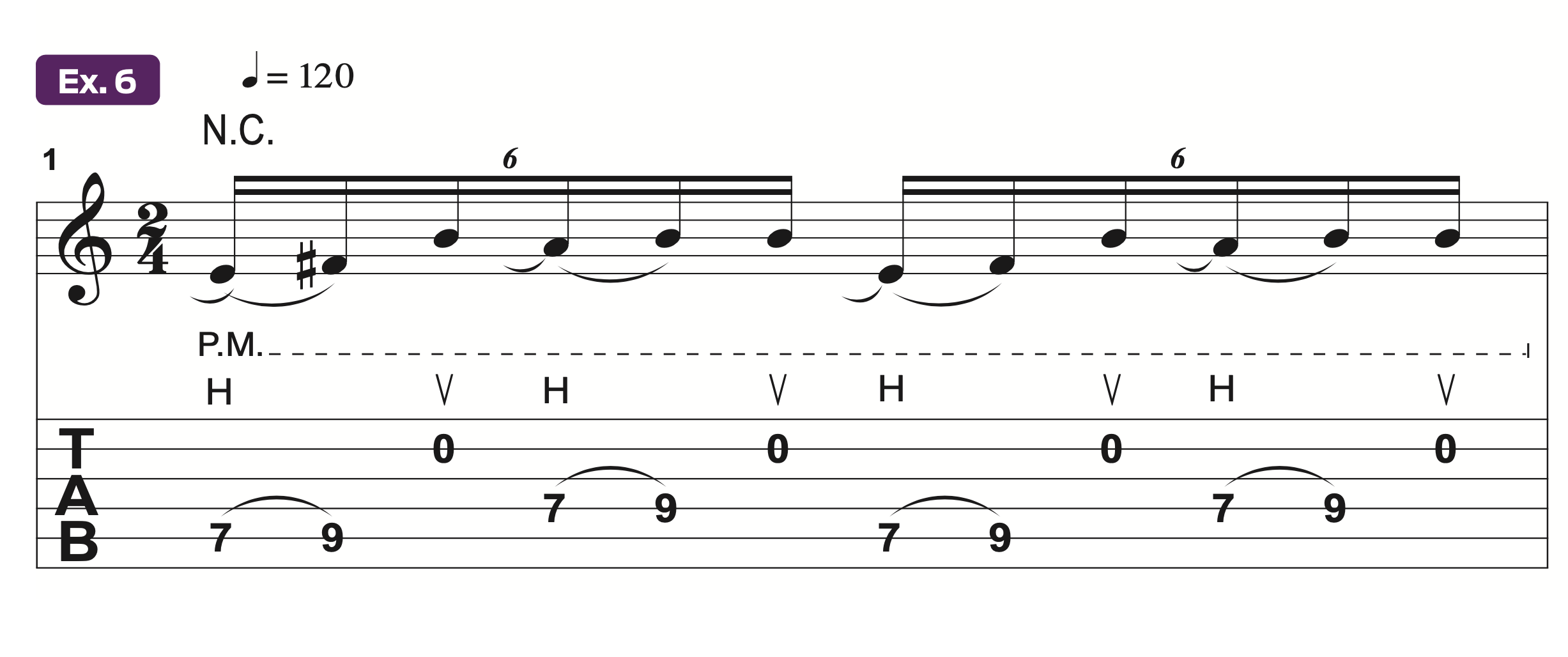
Once more taking advantage of an open string, this time his B, John shifts into a more modern gear for Ex. 6, a passage from his recently recorded track The Ghost. Using a technique reminiscent of the playing of Tosin Abasi and Roopam Garg, John pedals an open B note, which he picks repeatedly with an upstroke and quickly alternates with double hammer-ons on the A and D strings, all while palm muting.
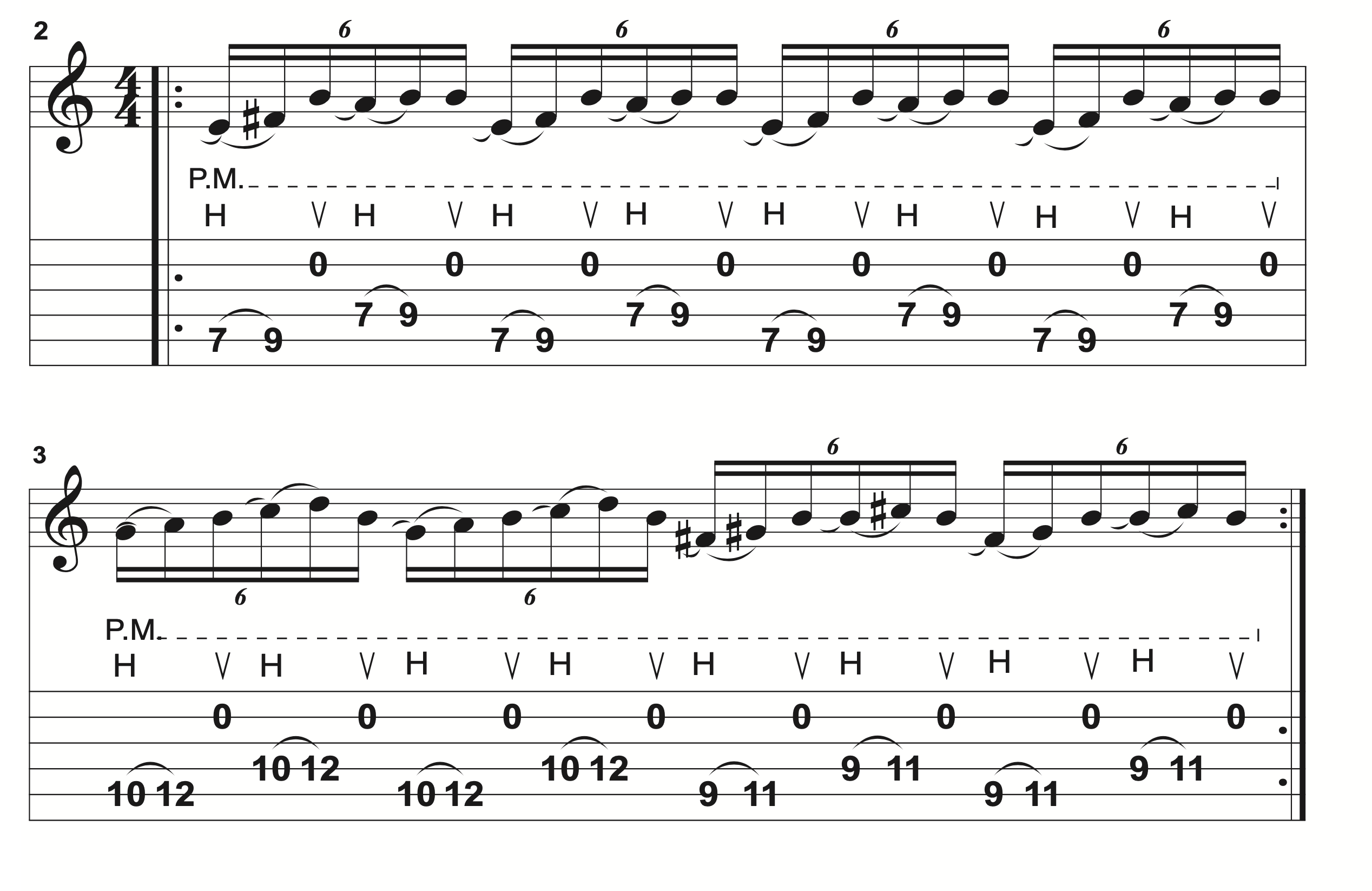
Notice that the first fretted note on each string is articulated with a fret-hand tap, or “hammer-on from nowhere,” indicated by an “H” in the tablature.
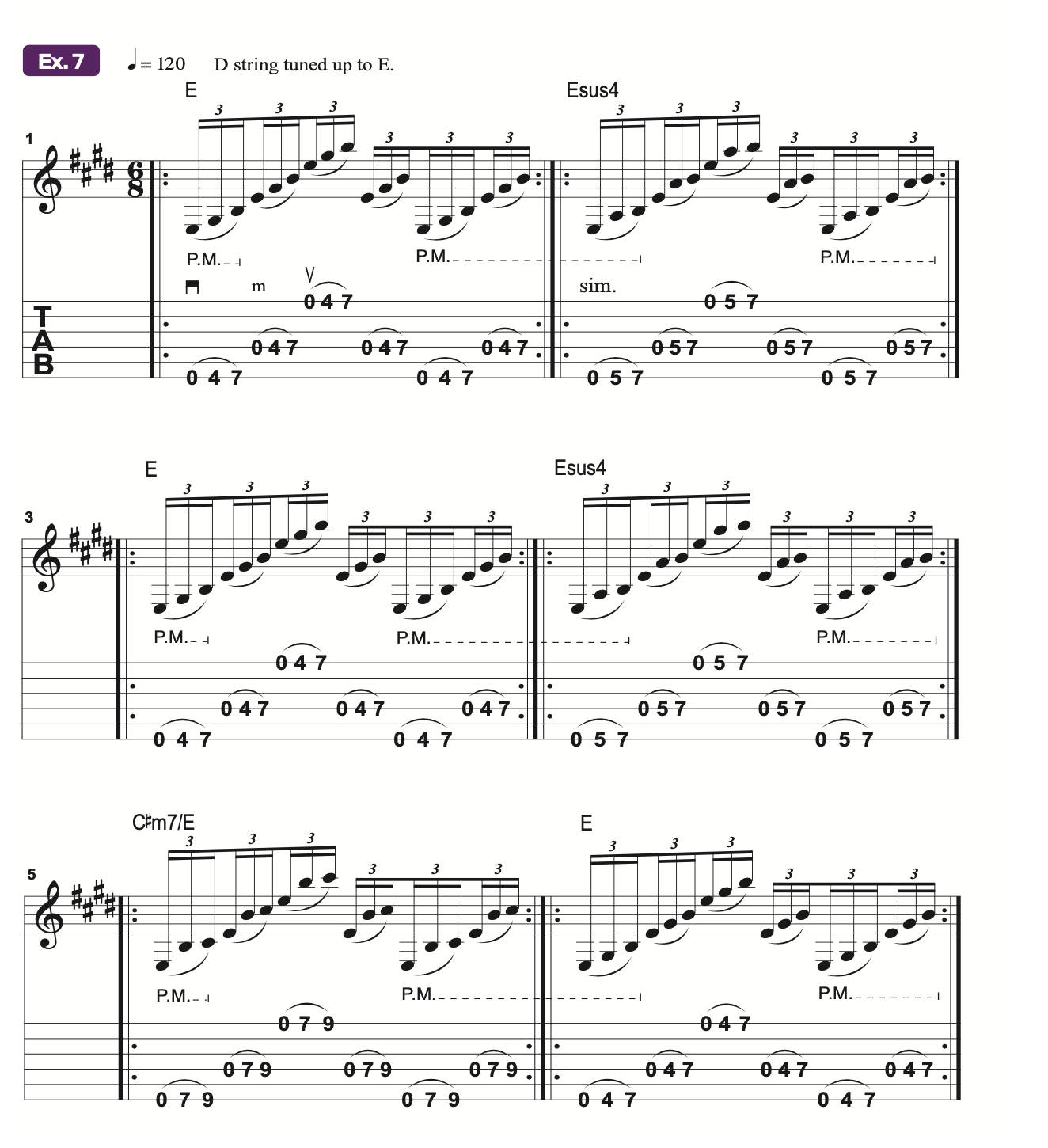
John extends his use of open strings and legato phrasing with Ex. 7, an acrobatic arpeggio-based string-skipping run he plays in Welcome to the Island (from Sinner), which outlines the arpeggios E (E, G#, B), Esus4 (E, A, B), and C#m7/E (E, B, C#). Note that he tunes his D string up a whole step here, to E, to attain three open E notes. He then proceeds to cleanly jump between the 6th, 4th, and 1st strings with double hammer-ons from each open string.

John switches techniques while continuing to burn up the Ghost’s white-painted fretboard with some more licks from Sinner, first with a return to Creepshow. He hits the clutch and shifts into a roller-coaster sweep-picking run (Ex. 8) that, again, will whip your head back and forth.
Making use of 2nd-inversion minor (5, 1, b3) and major (5, 1, 3) triad arpeggios on the top three strings, John flows through a progression in the key of E minor. He aptly demonstrates the need for intent and precision when sweep picking as he slices across the strings with the required uninterrupted downstroke, albeit with his professed “light touch.”
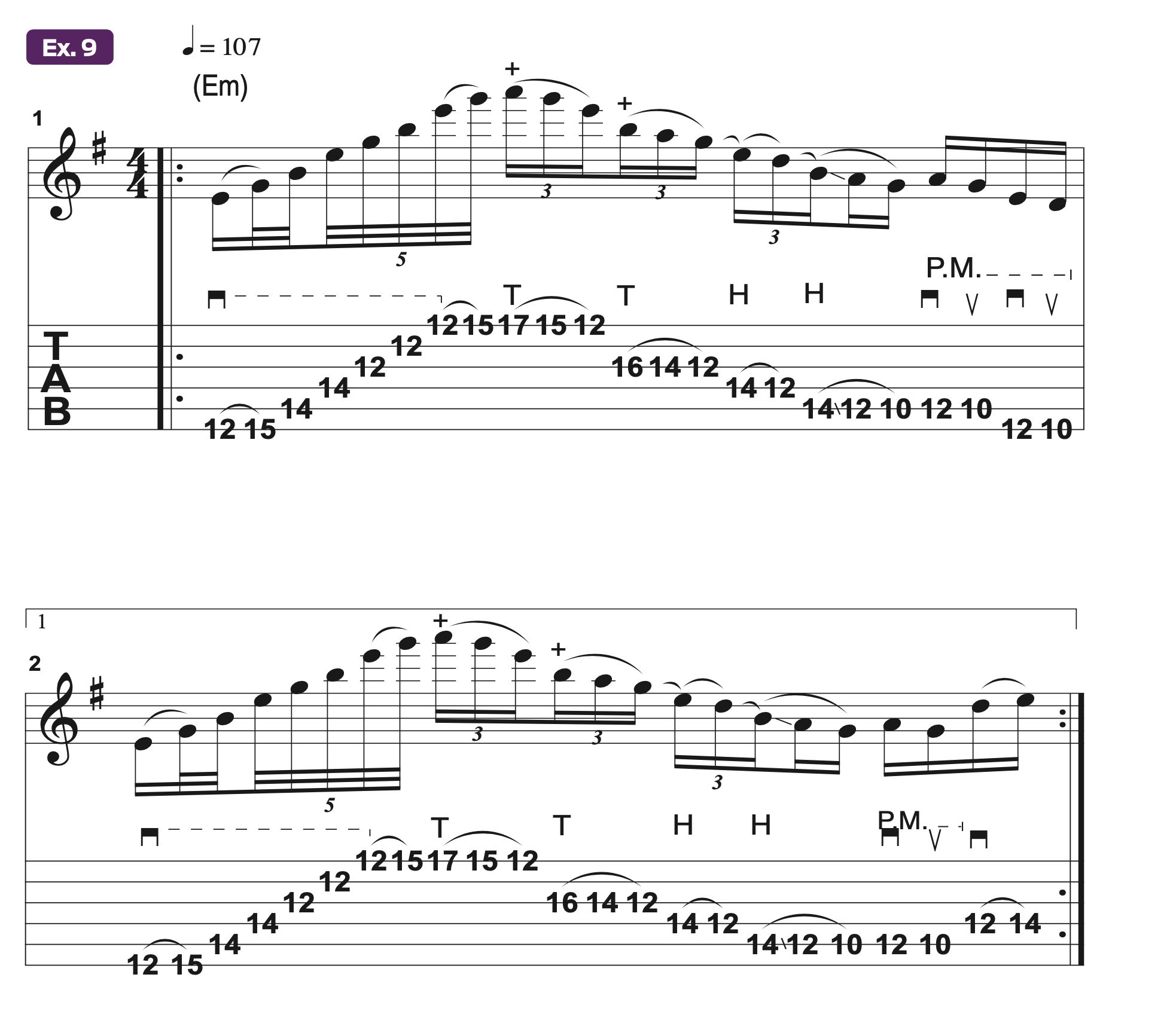
Ex. 9 grooves hard with a lick from Que Pasa. This canto pushes the envelope with full six-string sweeps of an Em arpeggio (E, G, B) bookended by minor 3rd hammer-ons from E to G.
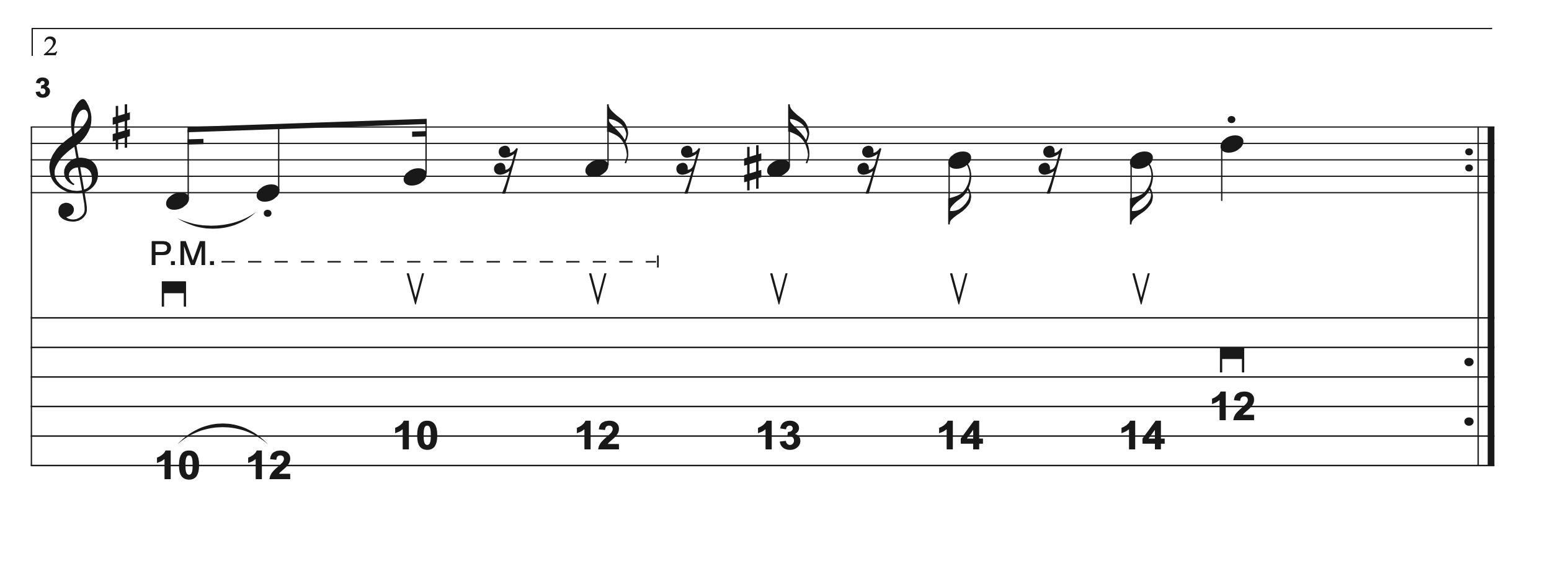
The apex of the run is a tapped 17th fret high A note that kicks off an avalanche of descending legato double and single pull-offs and finger slides.
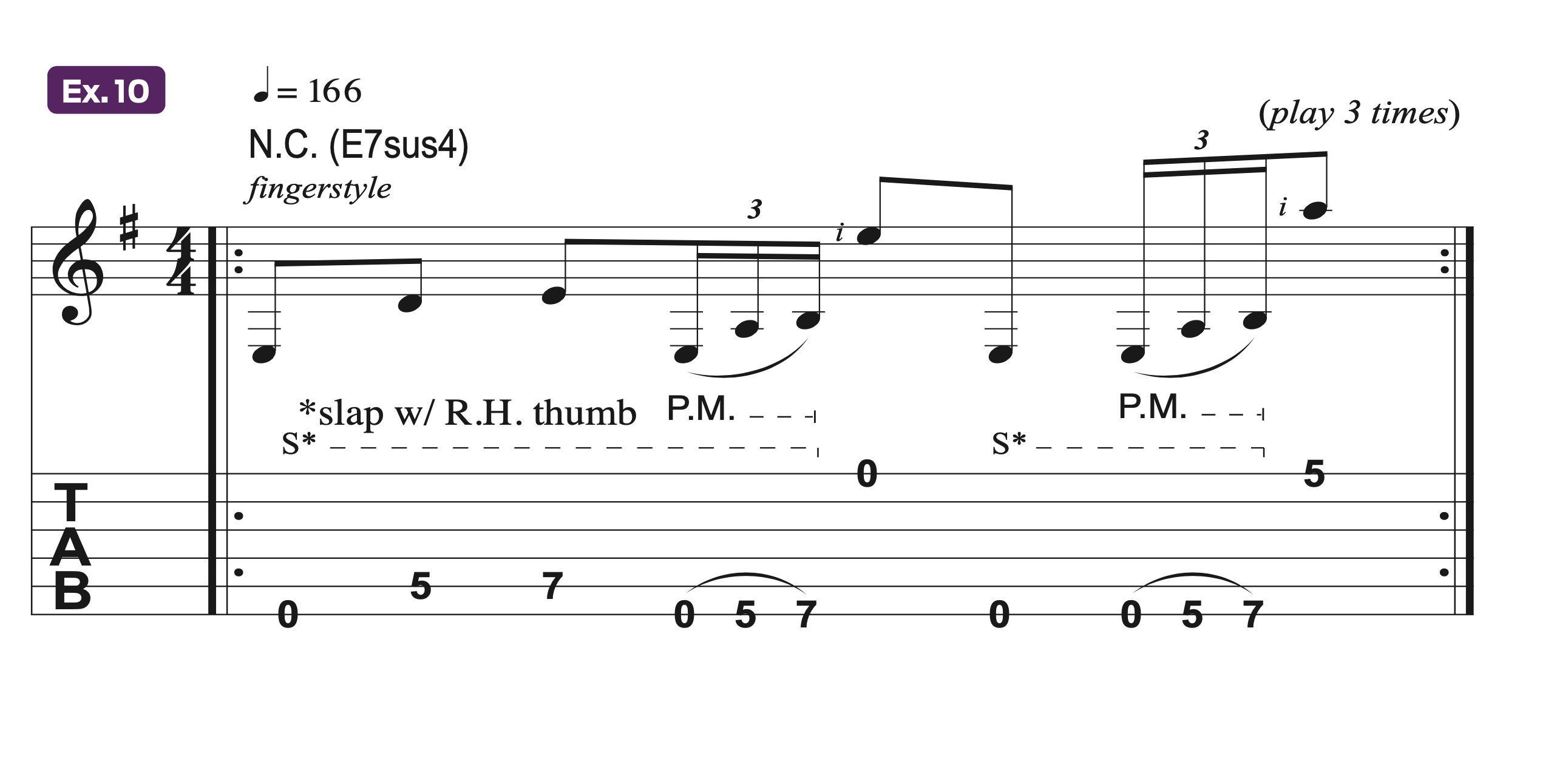
Pulling out yet another technique from his trick bag, John puts down his pick, rolls back the gain and proceeds to deconstruct the slap-guitar antics featured on his 2019 single, Zoinks!
Ex. 10 lays some groundwork as John’s thumb assumes a slapping motion (indicated by an S) on the 6th and 5th strings with intermittent double hammers-ons from – you guessed it – an open string, this time the low E. The solitary high E-string notes are attacked by his pick-hand first finger in what’s called a “pop.”
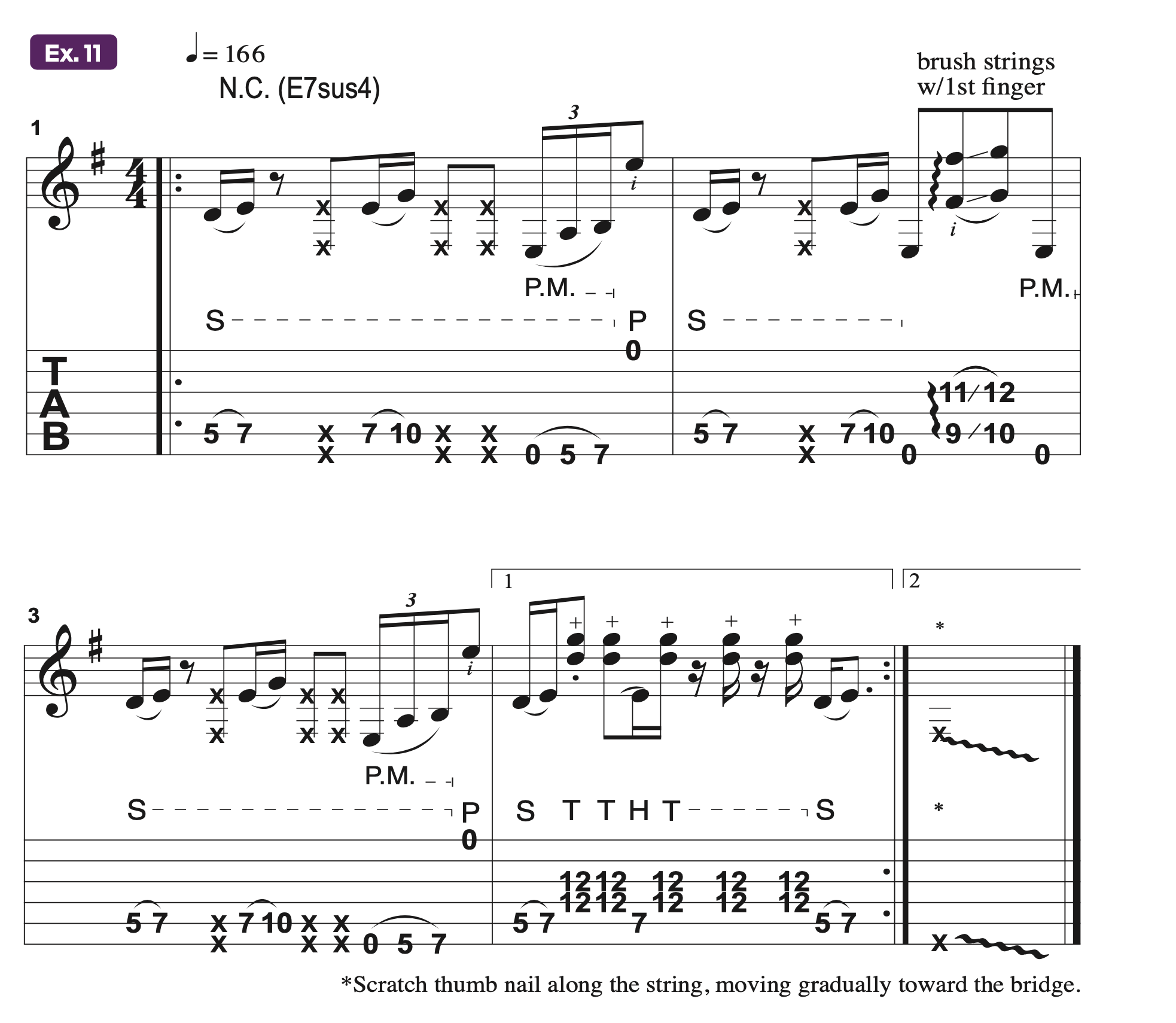
If the nod to Eddie Van Halen wasn’t apparent back in Ex. 4, it’s sure to come clear in Ex. 11, where John takes a walk down Mean Street with this additional four-bar phrase.
Expanding upon the techniques demonstrated earlier, he adds sliding octaves and the Edward-approved tapped perfect-4ths dyads on the D and G strings (tapped together, as a double-stop, with the pad, or “paw,” of his fret-hand index finger) before reminding us this is his show as he eerily scrapes his thumbnail down his low E string toward the bridge pickup. Considering the myriad jarring audio and visual images John has unleashed over his lauded career, this is par for the course.
Whether he’s performing on the world’s biggest stages or at home on a couch surrounded by his four-legged hairless companions and creating Instagram videos for nearly three-quarters of a million followers, John 5 is consistent. Put a guitar in his hands and be sure to have your finger on the record button, because he’s always at the ready… and, as many record producers will attest, he needs only one take!
When asked for advice on how to achieve this level of consistency and competence, John simply offers, “It’s all in your mind and how you look at things. You just do it, and do it all the time. That’s how I look at the guitar. I just play guitar all the time, like breathing or walking.”
Get The Pick Newsletter
All the latest guitar news, interviews, lessons, reviews, deals and more, direct to your inbox!
Chris Buono is a top-selling TrueFire Artist with nearly 50 instructional videos, and a featured instructor on guitarinstructor.com. Bookending his years as a Berklee professor, he authored eight books, including the popular Guitarist’s Guide to Music Reading and his most recent publication, How to Play Outside Guitar Licks.
“Write for five minutes a day. I mean, who can’t manage that?” Mike Stern's top five guitar tips include one simple fix to help you develop your personal guitar style
"It’s like you’re making a statement. And you never know where it’ll lead." Pete Thorn shares the tip that convinced Joe Satriani he was the right guitarist for the SatchVai Band






















